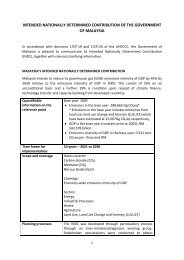RP-01638
RP-01638
RP-01638
Create successful ePaper yourself
Turn your PDF publications into a flip-book with our unique Google optimized e-Paper software.
Thailand<br />
Pichai Nimityongskul and Pisidhi<br />
Karasudhi<br />
The National Economic and Social Development<br />
Board of Thailand reports that more<br />
than 80% of the people in Thailand live in<br />
rural villages and that only 40% of these<br />
people have access to a safe water supply.<br />
Although people in the urban areas have<br />
a relatively good quality water supply, the<br />
supply in rural communities is far from<br />
adequate. In rural areas, potable water and<br />
water for other domestic purposes is obtained<br />
from various sources: rainwater catchment,<br />
deep or shallow wells, reservoirs, ponds, and<br />
streams. Of these sources, water from deep<br />
or shallow wells is the safest in terms of<br />
protection from waterborne diseases.<br />
Approximately 90% of the existing wells in<br />
Thailand use handpumps and over 5 million<br />
people depend on these handpumps to obtain<br />
their water for consumption and other<br />
domestic uses. As a result, handpumps are<br />
an integrated part of the life of the rural<br />
people and the operation and maintenance of<br />
these pumps poses a challenging task. It is<br />
estimated that the cost of repair and maintenance<br />
of the 7000 handpumps installed by<br />
the Department of Minerai Resources alone<br />
is over US$500 000 annually. Furthermore,<br />
NIDA (1978) reported that, based on a<br />
random sample, roughly 5000 of the 19 000<br />
handpumps installed in Thailand by different<br />
government agencies were out of operation<br />
on any given day.<br />
Purpose and Scope of the Project<br />
The main objective of this study was to test,<br />
under various field conditions, the handpump<br />
developed at the University of Waterloo and<br />
subsequently to modify and optimize the<br />
handpump design to suit local conditions.<br />
Specifically, the aim of this study was to:<br />
(1) conduct a review of the handpumps<br />
currently used by the five main government<br />
agencies responsible for rural water supply<br />
in Thailand; (2) carry out laboratory tests on<br />
various handpump types, including the<br />
Waterloo pump, to compare their performance<br />
and endurance under various conditions;<br />
(3) install and conduct field tests of the<br />
Waterloo handpump configuration; and<br />
(4) based on the field and laboratory test<br />
results, adapt and improve the Waterloo<br />
design and field test the modified handpump<br />
under village conditions.<br />
This project was sponsored by the International<br />
Development Research Centre<br />
(IDRC) and carried out with the cooperation<br />
of the following Thai government agencies:<br />
Department of Minerai Resources (DMR),<br />
Ministry of Industry; Department of Health,<br />
Ministry of Public Health; Department of<br />
Public Works, Ministry of Interior; Office of<br />
Accelerated Rural Development (ARD),<br />
Ministry of Interior; and Agricultural<br />
Technology Office, Ministry of Agriculture<br />
and Cooperatives. In addition, the National<br />
Economic and Social Development Board of<br />
the Office of the Prime Minister served as<br />
the coordinator for these agencies.<br />
Review of Existing Handpumps in<br />
Thailand<br />
Historically, the existing handpumps in<br />
Thailand originated from Europe and North<br />
America and were designed for use by a<br />
single family in the developed countries. In<br />
developing countries, the pump was shared<br />
by many people living in the rural community<br />
and, because of the increased usage, it broke<br />
quite often and, in most cases, could not be<br />
repaired by the villagers. According to the<br />
ARD Office (1980), several different types of<br />
handpumps have been installed in Thailand<br />
by different government agencies. However,<br />
the different handpumps in Thailand can<br />
be broadly classified into two groups: the<br />
DMR handpumps and the ARD handpumps.<br />
The prototypes of the handpumps from<br />
the DMR are the Demster, Red Jacket, and<br />
other handpumps donated by, or procured<br />
from, the United States of America. This<br />
type of handpump has a three-pin lever with a<br />
cross head and a cylinder that generally has<br />
a plunger with two leather cup seals and a<br />
poppet valve at the plunger. The lower valve<br />
21



